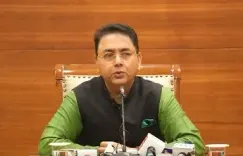How are India's Lower-Income States Surpassing Richer Ones?

Synopsis
Key Takeaways
- Lower-income states are showing signs of growth convergence post-pandemic.
- Increased public capital expenditure is driving growth in states like Assam and Uttar Pradesh.
- HSBC report highlights the potential for substantial catch-up growth.
- Central government resource transfers have increased, aiding state finances.
- Future GDP growth is projected at 6.5 percent in FY 2027–28.
New Delhi, Nov 26 (NationPress) Recent analysis reveals that India's lower-income states are beginning to demonstrate significant signs of "growth convergence" post-pandemic. This trend is highlighted by an increase in state public capital expenditure, enabling some previously lagging regions to outpace their wealthier counterparts, according to a report released on Wednesday.
States such as Assam, Uttar Pradesh, Rajasthan, and Bihar have emerged as notable examples, showcasing higher public capex and robust growth, as detailed in the report from HSBC Global Investment Research.
The report elaborates, "Regions with lower GDP per capita can experience substantial catch-up growth over several years, provided the conditions are favorable. This phenomenon is termed 'growth convergence' in the realm of economics and can significantly contribute to national growth."
HSBC analysts observed that states tend to boost their capex when they are financially stable, particularly among developing states. Additionally, the central government's resource transfers to states have increased following the pandemic.
However, the report cautions that a slowdown in tax revenue growth at the central level could potentially impede automatic transfers to states. Many states, especially those approaching elections, are unveiling new cash transfer initiatives, which presently do not seem to hinder capex but warrant attention.
Furthermore, the research group proposed that the central government should consider expanding the parameters of its capex loans to state programs.
They noted, "The central government can enhance the scale, diversify the application, increase flexibility, and improve predictability of these loans. This may provide clarity for the upcoming years, enabling states to embark on larger capex initiatives that require multi-year funding."
States also have the opportunity to contribute by simplifying regulations and implementing labor law reforms. Earlier this month, Morgan Stanley indicated that macroeconomic indicators remain stable, allowing policymakers to support growth through both monetary and fiscal strategies.
With expectations of growth in both rural and urban consumption, GDP is forecasted to rise by 6.5 percent in the fiscal year 2027–28, according to the report.









